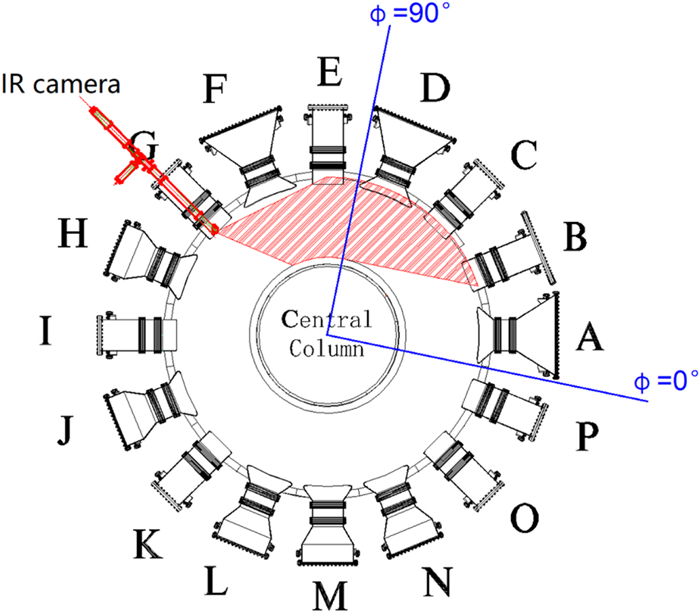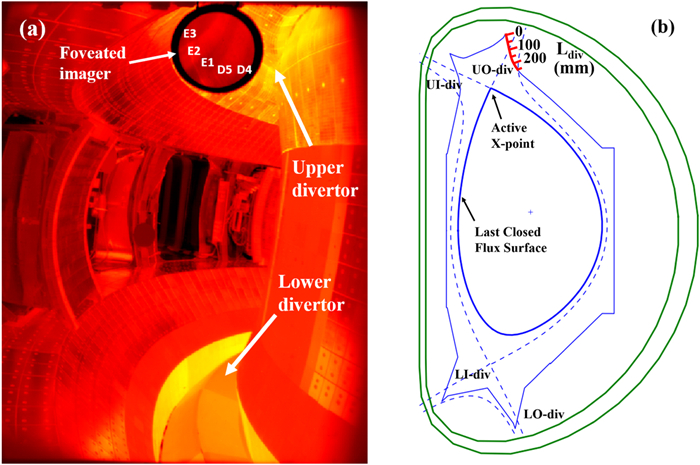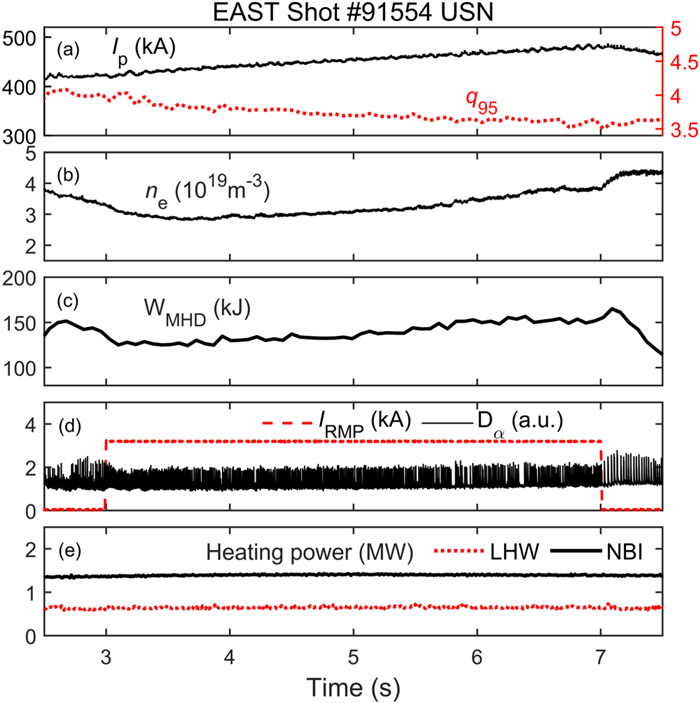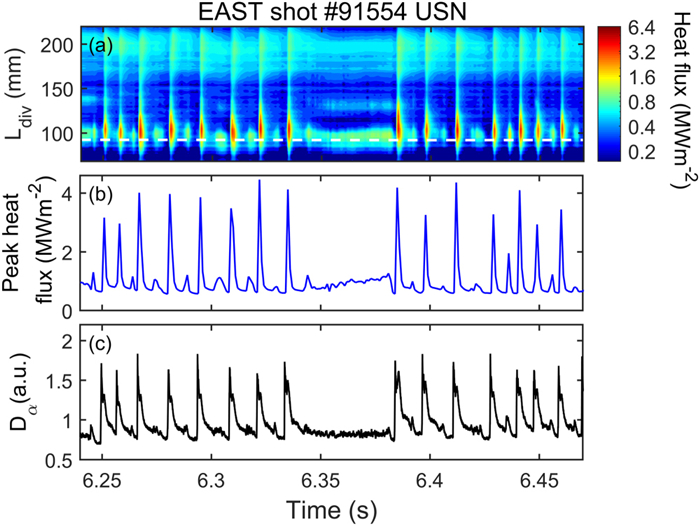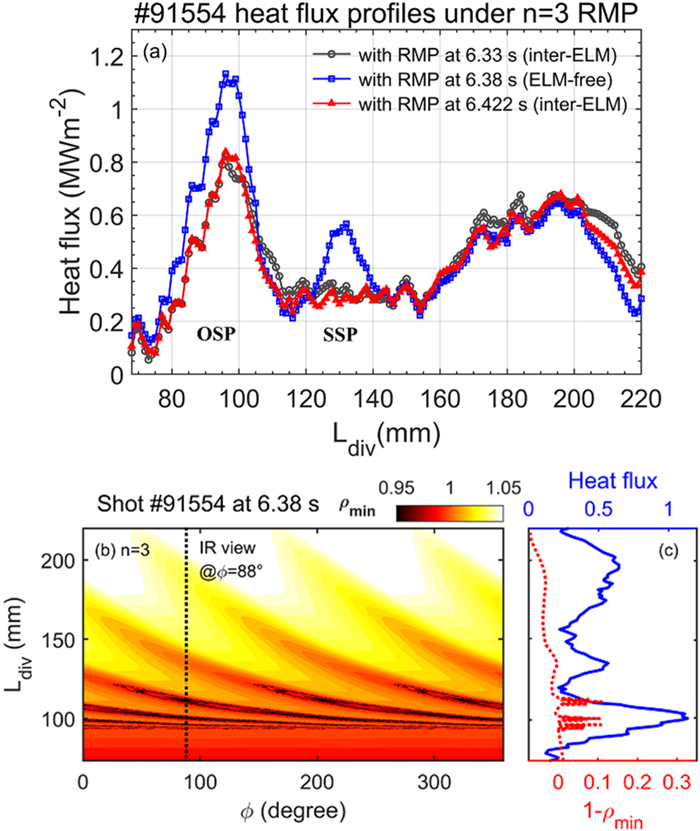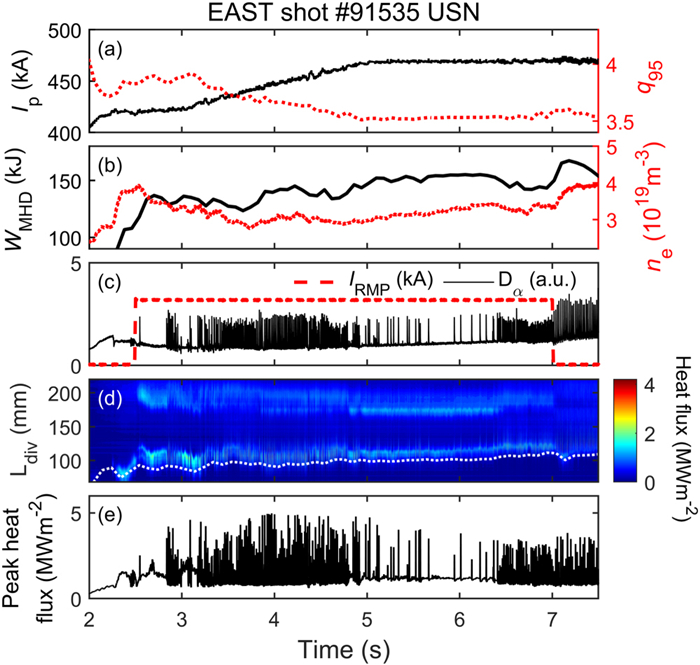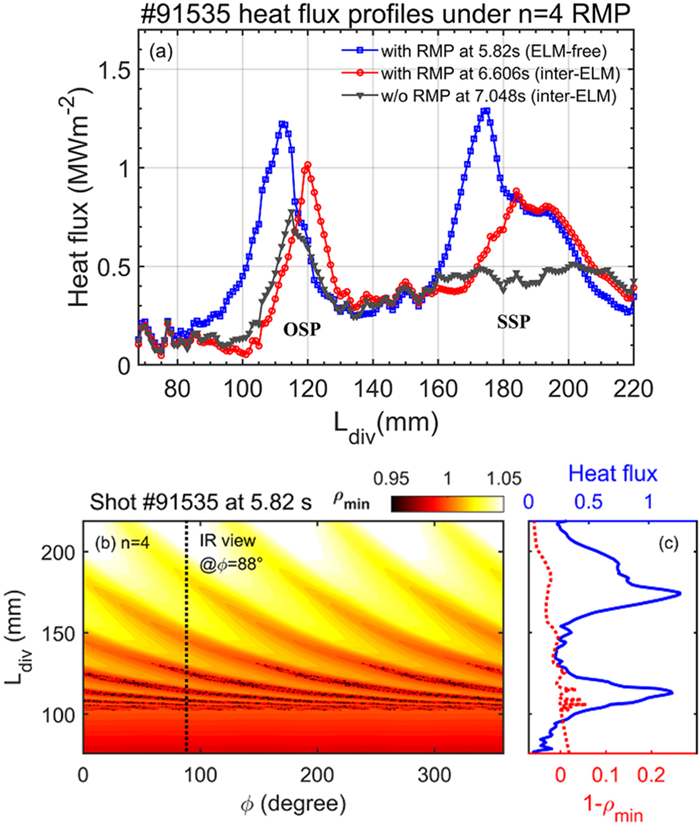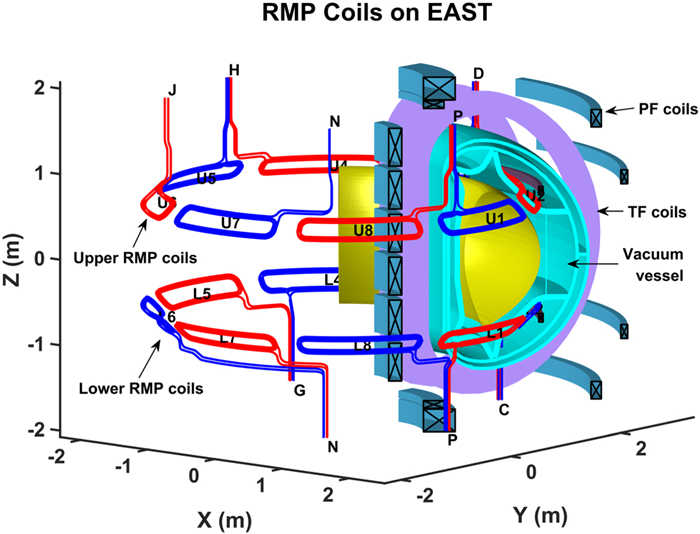
| Citation: | Ruirong LIANG, Xianzu GONG, Bin ZHANG, Zhendong YANG, Manni JIA, Youwen SUN, Qun MA, Jiayuan ZHANG, Yunchan HU, Jinping QIAN, the EAST Team. Study on divertor heat flux under n = 3 and n = 4 resonant magnetic perturbations using infrared thermography diagnostic in EAST[J]. Plasma Science and Technology, 2022, 24(10): 105103. DOI: 10.1088/2058-6272/ac73e6 |
Resonant magnetic perturbations (RMPs) with high toroidal mode number n are considered for controlling edge-localized modes (ELMs) and divertor heat flux in future ITER H-mode operations. In this paper, characteristics of divertor heat flux under high-n RMPs (n = 3 and 4) in H-mode plasma are investigated using newly upgraded infrared thermography diagnostic in EAST. Additional splitting strike point (SSP) accompanying with ELM suppression is observed under both RMPs with n = 3 and n = 4, the SSP in heat flux profile agrees qualitatively with the modeled magnetic footprint. Although RMPs suppress ELMs, they increase the stationary heat flux during ELM suppression. The dependence of heat flux on
Long pulse high-performance H-mode operation is the foreseen scenario for future fusion devices like ITER and CFETR. However, edge localized modes (ELMs) existing in H-mode plasma could lead to periodic bursts of tremendous transient heat flux striking the plasma-facing components, especially the divertor targets. Resonant magnetic perturbation (RMP) is an effective means of controlling ELMs and meanwhile manipulating stationary heat flux (SHF) [1–3]. Many devices have equipped with RMP coils for investigation on ELM and divertor heat flux control via RMPs, such as ASDEX Upgrade [4–8], DIII-D [3, 9–14], EAST [15–20], HL-2A [21, 22], JET [23, 24], KSTAR [25, 26], MAST [27–29], NSTX [30, 31], TEXTOR [32–35]. Theoretical simulation and experiment results have shown that the imposed external RMP field could modify the topology of edge magnetic field and induce the 2D pattern heat flux on divertor target often appearing as strike point splitting [6, 19, 27, 36]. The basic RMP parameters, i.e. RMP coil current (IRMP), toroidal mode number (n), current phase difference between the upper and lower coils (
EAST is a supper-conducting tokamak dedicated to long pulse H-mode operation and has equipped with an RMP system that can generate an RMP spectrum with a high toroidal mode number (n = 3 or 4) and infrared (IR) thermography diagnostic system that allows investigation of the divertor heat flux pattern. In this work, divertor heat flux characteristics under n = 3 and n = 4 RMPs are investigated using newly upgraded IR thermography diagnostic on EAST.
The structure of this paper is as follows. In section 2, the RMP system, IR diagnostic on EAST and heat flux calculation code are introduced. In section 3, experiment results on divertor heat flux under n = 3 and n = 4 RMPs are analyzed. Section 4 gives the summary.
Two arrays of in-vessel RMP coils have been symmetrically installed on the upper and lower parts of EAST device to generate 3D perturbated magnetic fields, as shown in figure 1(a). The upper array coils (named as U1–U8) and lower array coils (named as L1–L8) are evenly distributed along the toroidal direction, with each coil consisting of 4 turns. These sixteen RMP coils are controlled by a flexible power supply system enabling various RMP operation parameters. The maximum amplitude of RMP coil current IRMP can reach up to 3 kA (12 kAt) in DC, or AC mode commonly used to obtain rotating RMPs. The RMP coil arrays can form perturbated magnetic fields with toroidal mode number n from 1 to 4. RMP poloidal spectrum is then controlled by varying the phase difference between upper and lower coils defined as
The preferred diagnostic for surface temperature measurement on divertor target is infrared (IR) thermography. A set of IR/Visible integrated endoscope diagnostic systems is installed at the midplane of EAST on port G as shown in figure 2. The system monitors in the clockwise direction and covers the ports from E to B, as indicated by the red shaded area in figure 2. The optic is designed with a large field of view (FOV) of 49.5°×62° and is capable to monitor the upper and lower divertor targets simultaneously, as shown in figure 3(a). The IR camera is a TELOPS TS-IR MW MCT model, with a sampling rate of 115 Hz at a full frame size of 640×512 and up to 4.8 kHz at a reduced frame of 72×40 pixels [38]. The working bandwidth of the IR camera is 3‒4.9 μm with a temperature measurement range of room temperature (RT) to 2500 ℃. Recently, the IR diagnostic system has been upgraded by developing a dynamic foveated imager system which improves the local spatial resolution from 4 mm pixel-1 to 2 mm pixel-1 on divertor targets [39]. In this study, the IR camera was set in a small window of 184×160 pixels with a sampling rate of 1 kHz viewing on the upper-outer (UO) diverter through the foveated imager. As figure 3(a) shows, the location of the dynamic foveated imager was fixed at the view of divertor on ports D and E, covering five ITER-like tungsten divertor cassettes named D4, D5, E1, E2 and E3, and the D5 cassette (at a toroidal angle
In order to get a reliable surface temperature measurement of divertor target, careful calibration of IR parameters has been carried out using a blackbody furnace with a temperature range of RT to 700 ℃, indicating that the transmittance of the optical path is 0.19 at the central area of foveated imager. The emissivity of the tungsten monoblock surface at the upper divertor is 0.55, which is calibrated during vacuum baking with the help of the thermocouple system on EAST.
Divertor heat flux profile at one fixed toroidal angle is then calculated by a newly self-developed computation code using surface temperature obtained by the IR camera based on the finite element method, which is dedicated to EAST W/Cu monoblock divertor with active water-cooling. The reliability of this code was verified by comparing the calculation results with ANSYS under the same condition [40]. During the plasma shots, the formation of a thin layer on the divertor surface due to depositions not only affects the temperature measurement accuracy of IR system but also reduces the thermal conductivity of divertor target. For evaluating the influence of this thin layer, a heat transmission coefficient (so called alpha factor) is introduced into the heat flux calculation code, with its value determined by a criterion of the energy deposition equilibrium, i.e. the energy deposition on the divertor target should keep constant after the discharge terminated, since no more heat flux from plasma would deposit on divertor. The alpha value of 12 500 W m-2 K-1 satisfies the criterion and is used for the following heat flux calculations.
As is known that
As RMP was switched on, there was a slight descent in plasma density ne and stored energy WMHD due to RMP pump-out effect [2, 42]. However, as plasma evolved, plasma density and stored energy gradually increased and recovered to the level before RMP application. ELMs were mitigated during the whole RMP application, appearing as the increase in ELM frequency and decrease in ELM amplitude, indicated by the Dα signals shown in figure 4(d). In terms of ELM suppression, it was observed when
The comparison between heat flux profiles at ELM suppression and nearby inter-ELM phases is shown in figure 6(a). Compared to inter-ELM heat flux, heat flux during ELM suppression increased at the original strike point (OSP) by a factor of 37%. Besides, there appeared an SSP at the position around 120–140 mm, while no SSP was found at the same position in inter-ELM heat flux profiles. During RMP application, the formation of magnetic lobes structure is responsible for the strike point splitting in particle flux and heat flux [6, 19, 23]. To qualitatively understand the splitting heat flux pattern, a magnetic footprint modeling in a vacuum paradigm is implemented by field line tracing code TOP2D [18]. In the modeling, we use
This phenomenon of further splitting in heat flux profile synchronous with ELM suppression was also observed in shot #91535 under n = 4 RMP application. In this shot, RMP was applied from 2.5 to 7.0 s with parameters: n = 4, IRMP = 3 kA and
In order to investigate the effect of high-n RMP application and also ELM suppression on heat flux, heat flux profiles at time slices of 5.820 s (ELM suppression), 6.606 s (inter-ELM with RMP) and 7.048 s (inter-ELM without RMP) are selected to compare in figure 8. At these time slices,
The magnetic footprint by n = 4 RMP at a time slice of 5.82 s during ELM suppression is given in figure 8(b), and a comparison between shapes of magnetic footprint and heat flux profile is shown in figure 8(c). The SSP in heat flux at the position of 160‒220 mm agrees qualitatively with the magnetic footprint.
In this paragraph, the preliminary investigation into the effect of
As shown above, the distribution of divertor SHF is effectively influenced by RMP application, and the induced SSP undertakes a considerable part of the heat flux. However, in terms of transient heat flux caused by ELM pulses, no significant changes in heat flux distribution were observed although RMPs (n = 3 or n = 4) were applied. As shown in figure 10, most portion of heat flux condenses at the OSP under both n = 3 and n = 4 RMPs, similar to the situation without RMPs.
Taking advantage of the upgraded infrared thermography diagnostic with a dynamic foveated imager system and the newly developed heat flux calculating code dedicated to W/Cu monoblock divertor with active water-cooling on EAST, characteristics of divertor heat flux in H-mode plasma under high-n RMPs (n = 3 and 4) were investigated. The additional strike point splitting accompanied by ELM suppression is observed under RMPs with both n = 3 and n = 4, implying a significant change in divertor heat flux distribution under ELM suppression. The SSP in heat flux agrees qualitatively with the modeled magnetic footprint. Although RMPs suppress the ELMs, as a cost, they increase the SHF during ELM suppression. The dependence of heat flux on
This work was supported by the National Key Research and Development Program of China (No. 2017YFA0402500), the National MCF Energy R&D Program of China (No. 2019YFE03040000), National Natural Science Foundation of China (Nos. 12005262 and 11975274), the Foundation of President of Hefei Institutes of Physical Science, CAS (No. YZJJ2018QN8), the Anhui Provincial Natural Science Foundation (No. 2108085J06), the Users with Excellence Program of Hefei Science Center CAS (Nos. 2021HSC-UE018 and 2020HSC-UE011), External Cooperation Program of Chinese Academy of Sciences (No. 116134KYSB20180035), Science Foundation of Institute of Plasma Physics, Chinese Academy of Sciences (No. DSJJ-2021-04).
| [1] |
Loarte A et al 2014 Nucl. Fusion 54 033007 doi: 10.1088/0029-5515/54/3/033007
|
| [2] |
Evans T E 2015 Plasma Phys. Control. Fusion 57 123001 doi: 10.1088/0741-3335/57/12/123001
|
| [3] |
Jakubowski M W et al 2009 Nucl. Fusion 49 095013 doi: 10.1088/0029-5515/49/9/095013
|
| [4] |
Suttrop W et al 2011 Phys. Rev. Lett. 106 225004 doi: 10.1103/PhysRevLett.106.225004
|
| [5] |
Brida D et al 2017 Nucl. Fusion 57 116006 doi: 10.1088/1741-4326/aa78b9
|
| [6] |
Faitsch M et al 2017 Plasma Phys. Control. Fusion 59 095006 doi: 10.1088/1361-6587/aa75e7
|
| [7] |
Faitsch M et al 2017 Nucl. Mater. Energy 12 1020 doi: 10.1016/j.nme.2017.03.008
|
| [8] |
Sieglin B et al 2017 Nucl. Fusion 57 066045 doi: 10.1088/1741-4326/aa6c20
|
| [9] |
Evans T E et al 2008 Nucl. Fusion 48 024002 doi: 10.1088/0029-5515/48/2/024002
|
| [10] |
Briesemeister A R et al 2017 Nucl. Fusion 57 076038 doi: 10.1088/1741-4326/aa70bd
|
| [11] |
Cui L et al 2017 Nucl. Fusion 57 116030 doi: 10.1088/1741-4326/aa7efe
|
| [12] |
Jakubowski M W et al 2011 J. Nucl. Mater. 415 S901 doi: 10.1016/j.jnucmat.2010.12.005
|
| [13] |
Jia M et al 2018 Phys. Plasmas 25 056102 doi: 10.1063/1.5019777
|
| [14] |
Wade M R et al 2015 Nucl. Fusion 55 023002 doi: 10.1088/0029-5515/55/2/023002
|
| [15] |
Sun Y et al 2017 Nucl. Fusion 57 036007 doi: 10.1088/1741-4326/57/3/036007
|
| [16] |
Sun Y et al 2016 Phys. Rev. Lett. 117 115001 doi: 10.1103/PhysRevLett.117.115001
|
| [17] |
Sun Y et al 2021 Nucl. Fusion 61 106037
|
| [18] |
Jia M et al 2016 Plasma Phys. Control. Fusion 58 055010 doi: 10.1088/0741-3335/58/5/055010
|
| [19] |
Jia M et al 2018 Nucl. Fusion 58 046015 doi: 10.1088/1741-4326/aaaecc
|
| [20] |
Jia M N et al 2021 Nucl. Fusion 61 106023 doi: 10.1088/1741-4326/ac21f9
|
| [21] |
Sun T F et al 2021 Nucl. Fusion 61 036020 doi: 10.1088/1741-4326/ac1a1d
|
| [22] |
Sun T F et al 2019 Fusion Eng. Des. 148 111301 doi: 10.1016/j.fusengdes.2019.111301
|
| [23] |
Harting D M et al 2012 Nucl. Fusion 52 054009 doi: 10.1088/0029-5515/52/5/054009
|
| [24] |
Rack M et al 2014 Nucl. Fusion 54 064012 doi: 10.1088/0029-5515/54/6/064012
|
| [25] |
Jeon Y M et al 2012 Phys. Rev. Lett. 109 035004 doi: 10.1103/PhysRevLett.109.035004
|
| [26] |
In Y et al 2017 Nucl. Fusion 57 116054 doi: 10.1088/1741-4326/aa791c
|
| [27] |
Thornton A J et al 2014 Nucl. Fusion 54 064011 doi: 10.1088/0029-5515/54/6/064011
|
| [28] |
Harrison J R et al 2014 Nucl. Fusion 54 064015 doi: 10.1088/0029-5515/54/6/064015
|
| [29] |
Kirk A et al 2012 Phys. Rev. Lett. 108 255003 doi: 10.1103/PhysRevLett.108.255003
|
| [30] |
Ahn J W et al 2011 Phys. Plasmas 18 056108 doi: 10.1063/1.3574522
|
| [31] |
Ahn J W et al 2010 Nucl. Fusion 50 045010 doi: 10.1088/0029-5515/50/4/045010
|
| [32] |
Jakubowski M W et al 2004 Nucl. Fusion 44 S1 doi: 10.1088/0029-5515/44/6/S01
|
| [33] |
Jakubowski M W et al 2007 Plasma Phys. Control. Fusion 49 S109 doi: 10.1088/0741-3335/49/7/S08
|
| [34] |
Jakubowski M W et al 2007 J. Nucl. Mater. 363–365 371 doi: 10.1016/j.jnucmat.2007.01.158
|
| [35] |
Schmitz O et al 2008 Nucl. Fusion 48 024009 doi: 10.1088/0029-5515/48/2/024009
|
| [36] |
Schmitz O et al 2008 Plasma Phys. Control. Fusion 50 124029 doi: 10.1088/0741-3335/50/12/124029
|
| [37] |
Munaretto S et al 2022 Nucl. Fusion 62 026018 doi: 10.1088/1741-4326/ac3b89
|
| [38] |
Chen M W et al 2020 Fusion Eng. Des. 150 111415 doi: 10.1016/j.fusengdes.2019.111415
|
| [39] |
Zhang J Y et al 2020 Rev. Sci. Instrum. 91 116101 doi: 10.1063/5.0013212
|
| [40] |
Yang Z D et al 2020 Fusion Eng. Des. 152 111448 doi: 10.1016/j.fusengdes.2019.111448
|
| [41] |
Nazikian R et al 2015 Phys. Rev. Lett. 114 105002 doi: 10.1103/PhysRevLett.114.105002
|
| [42] |
Liang Y et al 2010 Phys. Rev. Lett. 105 065001 doi: 10.1103/PhysRevLett.105.065001
|
| [43] |
Lao L L et al 1985 Nucl. Fusion 25 1611 doi: 10.1088/0029-5515/25/11/007
|
| [44] |
Feng Y, Sardei F and Kisslinger J 1999 J. Nucl. Mater. 266–269 812 doi: 10.1016/S0022-3115(98)00844-7
|
| [45] |
Feng Y et al 2004 Contrib. Plasma Phys. 44 57 doi: 10.1002/ctpp.200410009
|
| [1] | Bo SHI (史博), Jinhong YANG (杨锦宏), Cheng YANG (杨程), Desheng CHENG (程德胜), Hui WANG (王辉), Hui ZHANG (张辉), Haifei DENG (邓海飞), Junli QI (祁俊力), Xianzu GONG (龚先祖), Weihua WANG (汪卫华). Double-null divertor configuration discharge and disruptive heat flux simulation using TSC on EAST[J]. Plasma Science and Technology, 2018, 20(7): 74006-074006. DOI: 10.1088/2058-6272/aab48e |
| [2] | P DREWS, H NIEMANN, J COSFELD, Y GAO, J GEIGER, O GRULKE, M HENKEL, D HÖSCHEN, K HOLLFELD, C KILLER, AKRÄMER-FLECKEN, Y LIANG, S LIU, D NICOLAI, O NEUBAUER, M RACK, B SCHWEER, G SATHEESWARAN, L RUDISCHHAUSER, N SANDRI, N WANG, the W-X Team. Magnetic configuration effects on the edge heat flux in the limiter plasma on W7-X measured using the infrared camera and the combined probe[J]. Plasma Science and Technology, 2018, 20(5): 54003-054003. DOI: 10.1088/2058-6272/aaa968 |
| [3] | MA Jun (马骏), QIN Hong (秦宏), YU Zhi (于治), LI Dehui (李德徽). Nonlinear Simulations of Coalescence Instability Using a Flux Difference Splitting Method[J]. Plasma Science and Technology, 2016, 18(7): 714-719. DOI: 10.1088/1009-0630/18/7/03 |
| [4] | GAO Jinming (高金明), LI Wei (李伟), LU Jie (卢杰), XIA Zhiwei (夏志伟), YI Ping (易萍), LIU Yi (刘仪), YANG Qingwei (杨青巍), HL-A Team. Infrared Imaging Bolometer for the HL-2A Tokamak[J]. Plasma Science and Technology, 2016, 18(6): 590-594. DOI: 10.1088/1009-0630/18/6/02 |
| [5] | ZHANG Jingyang (张镜洋), HAN Le (韩乐), CHANG Haiping (常海萍), LIU Nan (刘楠), XU Tiejun (许铁军). The Corrected Simulation Method of Critical Heat Flux Prediction for Water-Cooled Divertor Based on Euler Homogeneous Model[J]. Plasma Science and Technology, 2016, 18(2): 190-196. DOI: 10.1088/1009-0630/18/2/16 |
| [6] | GAO Yu(高宇), GAN Kaifu(甘开福), GONG Xianzu(龚先祖), GAO Xiang(高翔), LIANG Yunfeng(梁云峰), EAST Team. Study of Striated Heat Flux on EAST Divertor Plates Induced by LHW Using Infrared Camera[J]. Plasma Science and Technology, 2014, 16(2): 93-98. DOI: 10.1088/1009-0630/16/2/02 |
| [7] | GAO Jinming (高金明), LI Wei (李伟), XIA Zhiwei (夏志伟), PAN Yudong (潘宇东), et al.. Analysis of Divertor Heat Flux with Infrared Thermography During Gas Fuelling in the HL-2A Tokamak[J]. Plasma Science and Technology, 2013, 15(11): 1103-1107. DOI: 10.1088/1009-0630/15/11/05 |
| [8] | WANG Fumin (王福敏), GAN Kaifu (甘开福), GONG Xianzu (龚先祖), EAST team. Temperature Distribution and Heat Flux on the EAST Divertor Targets in H-Mode[J]. Plasma Science and Technology, 2013, 15(3): 225-229. DOI: 10.1088/1009-0630/15/3/07 |
| [9] | Kazumichi NARIHARA, Hiroshi HAYASHI. Asphericalizing the Light Collection Mirror for the 200-Point Thomson Scattering Diagnostic Installed on the Large Helical Device[J]. Plasma Science and Technology, 2011, 13(4): 415-419. |
| [10] | SHI Nan (史楠), GAO Xiang (高翔), JIE Yinxian (揭银先), ZHANG Shoubiao (张寿彪), ZENG Long (曾龙), WANG Erhui (王二辉), YANG Yao (杨耀), LIU Zixi (刘子奚). Far-Infrared Laser Diagnostics in EAST[J]. Plasma Science and Technology, 2011, 13(3): 347-351. |
| 1. | Krieger, K., Brezinsek, S., Coenen, J.W. et al. Scrape-off layer and divertor physics: Chapter 5 of the special issue: on the path to tokamak burning plasma operation. Nuclear Fusion, 2025, 65(4): 043001. DOI:10.1088/1741-4326/adaf42 |
| 2. | Munaretto, S., Kleiner, A., Churchill, R.M. et al. Impact of error fields and error field correction on heat fluxes in SPARC. Nuclear Fusion, 2025, 65(4): 046007. DOI:10.1088/1741-4326/adb982 |
| 3. | Liang, R., Gong, X., Zhang, B. et al. Investigation of divertor heat flux characteristics under the influence of resonant magnetic perturbations on EAST. Nuclear Fusion, 2025, 65(2): 026021. DOI:10.1088/1741-4326/ad9b38 |
| 4. | He, Z., Liu, L., Gao, J. et al. Design of an infrared/visible endoscope system for HL-3 divertor observation. Journal of Instrumentation, 2024, 19(9): P09023. DOI:10.1088/1748-0221/19/09/P09023 |
| 5. | Yang, H., Sun, Y., Jia, M. et al. Dynamic control of divertor heat flux during n = 4 resonant magnetic perturbation edge localized mode suppression by small variation of q 95 in EAST. Nuclear Fusion, 2024, 64(9): 096018. DOI:10.1088/1741-4326/ad63b8 |
| 6. | Navarro, M., Romazanov, J., Kirschner, A. et al. Small resonant magnetic perturbations result in three-dimensional material transport in the fusion plasma edge. Nuclear Fusion, 2024, 64(4): 046015. DOI:10.1088/1741-4326/ad2b2d |
| 7. | Boinnard, T., Coelho, A.J., Loizu, J. et al. Plasma turbulence simulations in a diverted tokamak with applied resonant magnetic perturbations. Nuclear Fusion, 2023, 63(7): 076005. DOI:10.1088/1741-4326/acd403 |
